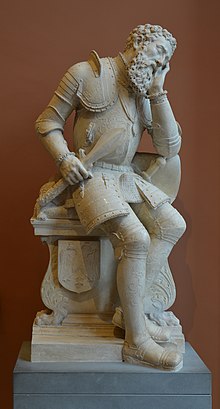This article needs additional citations for verification. (July 2008) |
Pierre Bontemps (c. 1505–1568) was a French sculptor known for his funeral monuments;[1] he was, with Germain Pilon, one of the pre-eminent sculptors of the French Renaissance.

He executed most of the bas-reliefs on the tomb of King Francis I of France, representing the French victories at the battle of Marignano and the battle of Ceresole.[2]
His also are the statues of the king, Queen Claude, the Dauphin, and Louis XII and Anne of Brittany on Louis' tomb in the Basilica of Saint-Denis. The figures from the tomb of Charles de Maigny (c. 1556) now reside in the Musée du Louvre.[3]
In 1936, a sale of contents from the chateau of Monchy-Humières included a full-length marble tomb which had been used as a garden ornament. Originally thought to be of Louis, duc d'Humières (1628–1694), it was in fact Jean III d'Humières (died 1553), executed by Bontemps. This is also in the Louvre.[4]
References
edit- ^ Watson, Ruth. "Heart-shaped worlds: Cordiform maps in the context of early modern Europe". The Globe (80): 1–12.
- ^ Cohen, Kathleen; Cohen, Kathleen Rogers (1973-01-01). Metamorphosis of a Death Symbol: The Transi Tomb in the Late Middle Ages and the Renaissance. University of California Press. ISBN 978-0-520-01844-0.
- ^ Bontemps, Pierre; France (1557), Tombeau de Charles de Maigny ou de Maigné (+ Paris, 1556), capitaine des gardes de la porte du Roi à partir de 1540, retrieved 2024-09-19
- ^ Penin, Marie Christine. "Humières, Louis de Crévant, Marquis, later duc". Tombes-sepultures. Retrieved 28 January 2019.